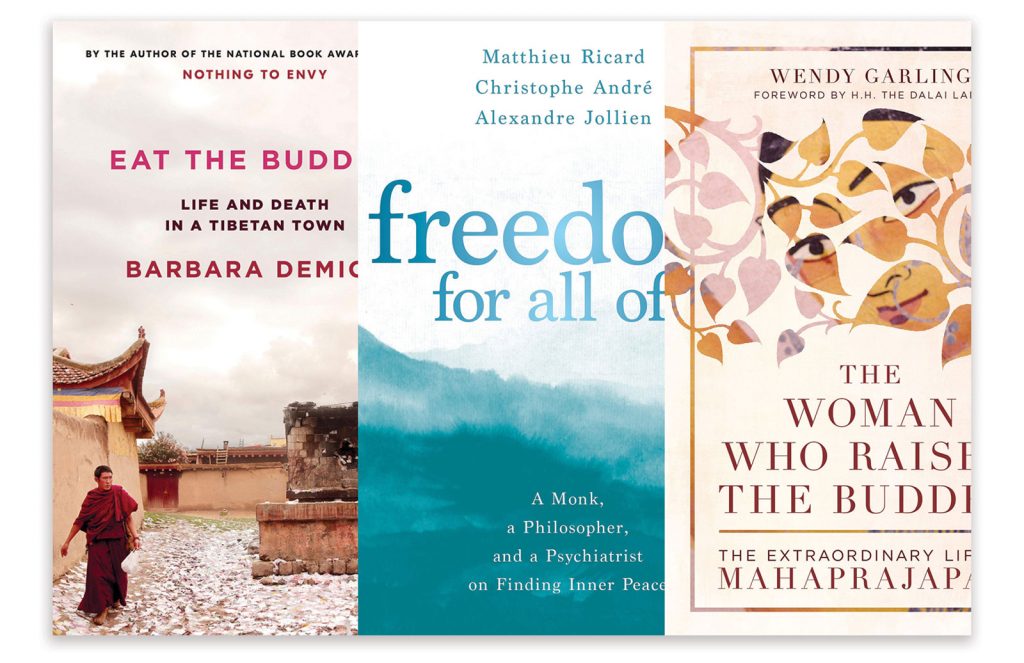
Eat the Buddha: Life and Death in a Tibetan Town
by Barbara Demick
Random House, July 2020, $28, 352 pp., cloth
Eat the Buddha is an engaging read about the history, culture, and heartache of Ngaba, a county in China’s Sichuan province, where Tibetan resistance to the Chinese Communists runs deep. Demick is an award-winning journalist who previously served as Beijing bureau chief for the Los Angeles Times. Using the narrative nonfiction approach of her previous two books (on Bosnia and North Korea), she tells the history of Ngaba through the lives of its residents. The result is an intimate portrait of the “undisputed world capital of self-immolations.” The author follows a Mei princess, protesting monks, a Chinese- Tibetan couple, and others who call this place home.
 The Woman Who Raised the Buddha: The Extraordinary Life of Mahaprajapati
The Woman Who Raised the Buddha: The Extraordinary Life of Mahaprajapati
by Wendy Garling
Shambhala Publications, March 2021, $18.95, 272 pp., paper
Many of us know the (short) story of Maya, the Buddha’s mother who died seven days after his birth. But what do we know about Mahaprajapati, Maya’s sister (who raised the Buddha and was the only mother he ever knew)? Wendy Garling, author of Stars at Dawn: Forgotten Stories of Women in the Buddha’s Life (2016), here continues to draw upon her research into women’s accounts buried in Pali and Sanskrit sources. Mahaprajapati is usually mentioned for advocating for the nuns’ order, but Garling highlights her role as a mother, wife, and queen whose story is intertwined with the origins of Buddhism.
 Freedom for All of Us: A Monk, a Philosopher, and a Psychiatrist on Finding Inner Peace
Freedom for All of Us: A Monk, a Philosopher, and a Psychiatrist on Finding Inner Peace
by Matthieu Ricard, Christophe André, and Alexandre Jollien
Sounds True, November 2020, $19.99, 368 pp., paper
A Buddhist monk, a philosopher, and a psychiatrist walk into a ski chalet. There is no punchline, just a rich, layered conversation on the nature of freedom and the question of how to become free. This book, according to the authors, is not a series of teachings but a record of three friends’ musings on how to escape the often prisonlike confines of our minds. Chapters on topics such as fear, addiction, culture, meditation, and emotional learning end with helpful reminders and takeaways for this timeless subject.

Scholar’s Corner
Be the Refuge: Raising the Voices of Asian American Buddhists
by Chenxing Han
North Atlantic Books, January 2021, $17.95, 344 pp., paper
What does it mean to be a young Asian American Buddhist? Chenxing Han, a writer with a master’s degree in Buddhist Studies from the Graduate Theological Union, gives us the most complete picture to date. Be the Refuge features voices and perspectives of 89 young people she interviewed, along with her personal story about becoming a Buddhist. Nearly two-thirds of Buddhists in America are Asian, and Han’s book highlights this “invisible majority.” Be the Refuge opens the door for deep and difficult conversations about race, religion, and representation—and sanghas with affinity groups ought to add this title to their reading lists.
WHAT WE’RE REREADING
 Life of the Buddha
Life of the Buddha
by Ashvaghosha, translated by Patrick Olivelle
We’re going way, way back with this lyrical pick. Written in the 1st or 2nd century CE by the Buddhist monk and poet Ashvaghosha, Life of the Buddha is the first comprehensive biography of the Buddha’s life. The Sanskrit verses recount the stories you’ve probably heard before— Siddhartha leaving the comforts of palace life behind after witnessing suffering, or fighting off Mara’s demons while meditating under the Bodhi tree—and other details that may be more obscure. The Indologist and Sanskrit scholar Patrick Olivelle dusted off this classic for the Clay Sanskrit Library, which published the new translation in 2008. If you are looking to learn more about early Buddhist lore, this is a great place to start.
Thank you for subscribing to Tricycle! As a nonprofit, we depend on readers like you to keep Buddhist teachings and practices widely available.
